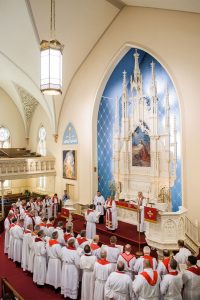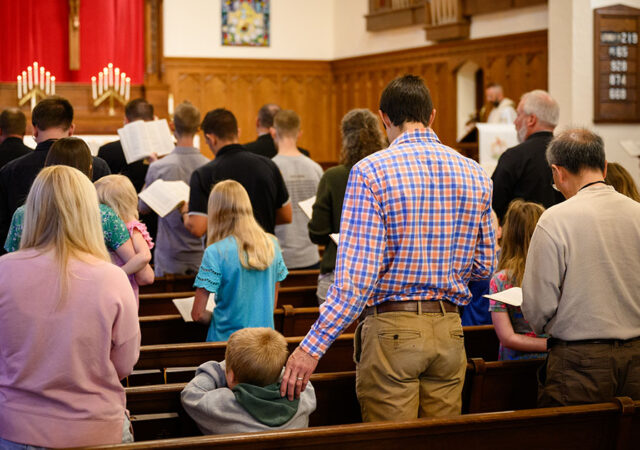By David Strand
ST. LOUIS — Meeting here Sept. 9-13, the LCMS Council of Presidents (COP) tackled a full agenda notable for its number of guest speakers addressing an array of subjects.
The COP invited Jane Dulle, chief operating officer of the Lutheran Federal Credit Union (LFCU), to provide an update on that still-new institution. Dulle reported that “growth is on target” and asked the district presidents to encourage their congregations, households and church workers to consider using the credit union — this in keeping with Resolution 10-02 from the Synod’s July convention: “To Commend Startup of the Lutheran Federal Credit Union and Promote Its Ongoing Work.”

Dulle pointed to “success stories” of the credit union, such as the Florida-Georgia District moving its “primary banking relationships” to the LFCU (saving $5,600 a year in lower fees) and the testimonies of happy customers, including a Lutheran Church Extension Fund employee who is saving $1,800 by refinancing her car through LFCU and an LCMS worker who cited the “good rates and exceptional service” she is enjoying on her LFCU home refinance.
She listed other services and benefits of the credit union — two key attributes being that the LFCU is “very member focused” and bases itself on “the same Christian values and biblical principles of stewardship” as the Synod.
James Sanft, president and chief executive officer of Concordia Plan Services (CPS), the Synod’s benefits administrator, described “a more state-of-the-art tool in the works” to help districts understand appropriate compensation levels for pastors based on several demographic factors. Much research has gone into developing this tool, which Sanft characterized as simply providing an online resource the districts may find useful in attempting to establish total compensation parameters for their pastors. CPS will demonstrate the tool to LCMS business managers, gaining their feedback, when the managers gather near Chicago in November.
Legal, regulatory issues facing CPS
The bulk of Sanft’s presentation centered on three societal issues facing CPS: the Affordable Care Act (and its contraceptive-services mandate), same-sex marriage and gender-identity issues.
Sanft said the “guiding principles” CPS will follow in dealing with these “collisions of church and culture” will be to protect the Concordia Plans (funded largely by ministries) from paying for goods and services that would violate the Synod’s beliefs, enable ministries and members to remain compliant with applicable laws and regulations, and preserve the qualified or tax-exempt status of the Concordia Plans for the sake of plan members.
Apart from these matters, he said a constant goal is to “retain and grow Plan membership.” The bigger the pool of members, he said, the broader the risk base, and thus better rates and greater efficiencies can be available to members of the CPS community.
The COP used several venues during its five-day meeting, starting off Friday at the International Center; spending part of Saturday at Holy Cross Lutheran Church and Concordia Publishing House in South St. Louis for the Service of Installation and reception afterward; visiting Concordia Seminary in Clayton, Mo., on Sunday to meet with the school’s president, the Rev. Dr. Dale A. Meyer, and faculty; returning to the International Center on Monday; and finishing up at the group’s airport hotel on Tuesday.
Sem reps on curriculum updates
During Sunday’s seminary session, several faculty representatives described the updates being made to the seminary’s curriculum — revisions designed to better serve the needs of students and the Synod itself. For example, a shift from quarterly terms to longer semesters will create more flexibility in course delivery, streamline administrative tasks and save on costs. Language courses will carry the same requirements but be spread over the entire four years of instruction. “We want our students to use the languages rather than just passing exams on them,” said the Rev. Dr. Jeffrey Kloha, seminary provost.
All in all, said the Rev. Dr. Joel P. Okamoto, associate professor and chairman of systematic theology, referring to an “FAQ” prepared by the Curriculum Committee, the purpose of the revisions is to help the seminary meet the emerging needs and opportunities of LCMS congregations while better addressing the learning, spiritual and personal growth priorities of the students. “We want to make the curriculum more adaptable to future realities,” he said.
For the COP’s part of the conversation that day, the Rev. Donald J. Fondow, president of the LCMS Minnesota North District, and the Rev. Derek G. Lecakes, president of the Atlantic District, gave presentations on the challenges of rural and small-town ministry and urban and cross-cultural ministry, respectively.
For all the obvious differences between these two milieus, both men cited similarities in the problems facing rural and inner-city congregations: financial struggles, dwindling and aging membership, a sense of hopelessness and leader fatigue, to name a few.
But each offered ideas to address these problems: doing a better job of identifying and preparing young pastors (and their wives) to serve in these settings, bolstering the church’s support of them so they don’t burn out and want to leave in two or three years, being open to alternative means of shepherding a congregation when a church can’t afford its own pastor, and encouraging pastors to be more visible and available — more involved — in their neighborhoods and communities.
Harrison voices satisfaction with convention
In his “President’s Report,” Synod President Rev. Dr. Matthew C. Harrison expressed deep satisfaction, with few exceptions, over the proceedings of the Milwaukee convention in July. He cited the “astoundingly overwhelming votes” that attested to the overall unity of the delegation. “My conviction,” he said, “is that if we rally around our historic doctrine and practice, evangelically applied, the more unity we will have in the Church.”
Of course “we have many challenges,” he added, pointing to the Synod’s end-of-year financials for the past fiscal year, which show that the church, while under-spending its budget by a significant amount, nonetheless “under-raised our budget… . We’ll be looking at all things, tightening our belts,” he said. “We’re not in crisis mode, but we’re watching our Ps and Qs.”
One of Harrison’s few concerns from Milwaukee involved “the long and winding road” of pre-convention disharmony, and protracted debate at the convention itself, regarding ecclesiastical supervision in the Synod and its attendant processes for appeals and expulsions. The task at hand is to bring the Synod’s Bylaws on these matters into accord with corresponding language in the LCMS Constitution. At Milwaukee, delegates adopted a substitute resolution (12-14) to replace the lengthily argued 12-01A. Both Harrison and the COP fully supported the new resolution, which gives the COP a greater role in advising Synod Secretary Rev. Dr. John Sias and the Commission on Constitutional Matters (CCM) on how the final Bylaw language, which the CCM will submit to the Synod’s Board of Directors for approval, should read.
At the COP meeting, Sias explained what the Constitution calls for and urged the council to “move as expeditiously as possible” on this [to allow for timely publication of the triennium’s Handbook and all the training and reference materials that rely on it]. At the same time, he gave ear to certain district presidents’ concerns that the process not be unduly rushed. At the end of the discussion, COP Chairman Rev. Ken Hennings, president of the Texas District, said “Thank you, Dr. Sias, for getting us started on this.”
Cultural trends, demographics
The COP also heard from Dr. George Hawley, assistant professor of political science at the University of Alabama, on how American cultural trends and U.S. and LCMS demographics are affecting the Church. By and large, the news is on the “gloomy” side when it comes to the Synod’s potential for growth.
But Hawley offered some rays of hope. For example, while “the younger generation of the LCMS is not that big, some 21 percent of LCMS people age 30-49 have at least three children.” By comparison, this figure in the Episcopalian Church stands at 4 percent.
Ryan Curnutt, senior research analyst for LCMS Rosters, Statistics and Research Services, affirmed Hawley’s point by saying “the number of children in the LCMS today is large enough to ‘replace’ its aging senior population.” The catch, he added, “is retaining these children.”
Hawley listed “three important elements a church needs to do”: take a stand on marriage, abortion and what a healthy family looks like; communicate this message; and encourage families to devote themselves to this task.
The COP devoted time not only for a Bible study but a doctrinal study as well — both concerning the priesthood of all believers and each presented by a professor at Concordia Seminary, St. Louis: the Rev. Dr. Mark Seifrid, professor of exegetical theology and a pre-eminent scholar of the New Testament letters of Paul, and the Rev. Dr. Paul Robinson, professor of historical theology and dean of the faculty.
Usual business
The balance of the agenda was taken up with more or less standard COP fare: committee reports, reinstatements to the roster, nominations for and appointments to commissions, updates to administrative documents, and small-group discussions.
COP Secretary Rev. Dr. Chris Wicher, president of the Eastern District, provided the following vacancy report for the 35 LCMS districts: sole pastor vacancies, 329; senior pastor vacancies, 48; associate/assistant pastor vacancies, 70; total vacancies, 447. Number of part-time pastors, 305; new ministry starts, 10; and congregations closed, 8.
The COP next meets Nov. 15-18, in conjunction with the Lutheran Church Extension Fund Fall Leadership Conference in Schaumburg, Ill.
David Strand (david.strand@lcms.org) is executive director of LCMS Communications.
Posted October 4, 2016





Hawley listed “three important elements a church needs to do”: take a stand on marriage, abortion and what a healthy family looks like; communicate this message; and encourage families to devote themselves to this task.
Be very careful how you do this “healthy family looks like”. Some not that long ago in history would have said that about marriage with different races, some said that about a woman working out side family duties. It would be easy to use things and not the love of Christ to meet “LOOKS LIKE”